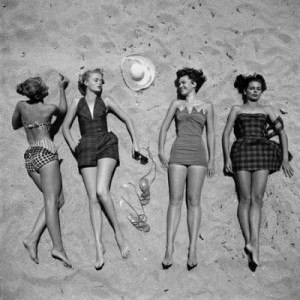“Itsy bitsy teeny weeny yellow polka dot bikini” is a phrase recognized nationwide. This little piece of fabric yields a revenue of 13.25 billion dollars annually thanks to the females who, according to statisticbrain.com, individually own an estimated four of these bathing suits.
However, swim suits did not become popular overnight. Bathing suit trends have come a long way throughout the years, transforming from modest and functional to trendy and stylish.
It all began in the 1800’s to early 1900’s when swim suits resembled dresses. They were referred to as “Bathing Gowns” and were made of a heavily weighted fabric like wool to prevent the dress from riding up.
The gowns then evolved into a “Princess Cut Suit”, a one-piece blouse with pants and a skirt that fell just below the knee, as women were encouraged to swim. Very little skin was exposed, emphasizing modesty.
And the policy to keep women covered up was strictly enforced.
In relation, Annette Kellerman was arrested for indecency in 1907 by Boston officials for wearing a loose one piece bathing suit that revealed her thighs. Soon after her arrest, bare legs became more acceptable to show as one pieces became the newest trend.
By the 1930’s, women were wearing one piece swim suits with an open back, which began to resemble modern bathing suits more closely.
The halter top and corset style became more popular as well during this time. Hollywood actresses were featured swimming in many films of the 1940’s. Films called “aqua musicals” were also a craze during this time. They showcased synchronized swimming and diving as well as intricate performances in the water. A talented woman named Esther Williams got her nickname, “America’s Mermaid”, after landing multiple roles in these aqua musicals.
Just in time, as the swim suit craze was full steam ahead, the bikini was introduced by Louis Reard, a French engineer, and Jacques Heim, a fashion designer.
But one pieces remained the trend throughout the 1950’s, however, as women were leaving the bikinis to the movie stars. Women were content with the one pieces that made them feel confident and attractive.
Right around this time was also when rubber swim caps donned with fancy flowers were in style.
As the 60’s rolled around, bikinis were finally acceptable. Bottoms sat just below the belly button. But by the time designers began experimenting with different styles in the 1970’s, very little was left to the imagination. Bathing suits covered much less as the bikini tops began to resemble bras and bikini bottoms were high cut to reveal the hips.
Not much more was covered up in the 1980’s. Neon colors along with skimpy bottoms were among some of the most popular styles. Finally, in the 90’s, bathing suits were manufactured for fun and tanning. Bikini tops had adjustable and criss-cross straps and bathing suits with odd designs caught the attention of many consumers as well.
Today, designers continue to experiment with new styles such as boy short bottoms, one pieces with cutouts on the stomach, and strapless tops. Mix and match bikini tops and bottoms along with sleek one pieces are among some other existing trends.
Because of all these new styles, the profit of swimwear industries today continues to explode as new trends are introduced annually.
Swimwear styles have certainly taken a turn from long sleeved shirts with heavy coats but trends will only continue to transform in years to come.



















